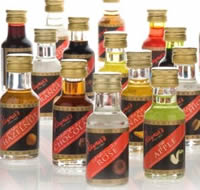Difference between Essence and Extract
Key difference: Essence and extract are both flavoring ingredients. An extract is made by combining oil from the ingredient with an alcohol. This creates a stable, longer-lasting flavoring agent. An essence, on the other hand, can have two distinct meanings. It can either be an imitation extract or it can be highly concentrated form of pure extract.
 Essence and extract are both flavoring ingredients. Both are mainly used in a number or recipes to give them the flavoring and/or aroma of the original ingredient. Commonly available essences and extracts are of spices, nuts, herbs, fruits, some flowers, etc. The best known of these are extracts or essences of almond, cinnamon, cloves, ginger, lemon, nutmeg, orange, peppermint, pistachio, rose, spearmint, vanilla, violet, and wintergreen.
Essence and extract are both flavoring ingredients. Both are mainly used in a number or recipes to give them the flavoring and/or aroma of the original ingredient. Commonly available essences and extracts are of spices, nuts, herbs, fruits, some flowers, etc. The best known of these are extracts or essences of almond, cinnamon, cloves, ginger, lemon, nutmeg, orange, peppermint, pistachio, rose, spearmint, vanilla, violet, and wintergreen.
Dictionary.com defines an extract as a substance separated or obtained “from a mixture by pressure, distillation, treatment with solvents, or the like.” While, as essence is “a substance obtained from a plant, drug, or the like, by distillation, infusion, etc., and containing its characteristic properties in concentrated form.”
While referring to food ingredients, an extract is made by combining oil from the ingredient with an alcohol. This creates a stable, longer-lasting flavoring agent. Alcohol is used as a binding agent for preserving the flavor’s strength. Ethyl alcohol and vodka are commonly used to make extracts, while, alcohols such as gin, brandy and rum may also be used.
An essence, on the other hand, can have two distinct meanings. It can either be an imitation extract or it can be a highly concentrated form of pure extract; the label on the bottle should specify which. Concentrated essences are essentially very strong extracts that can be twice to even four times as strong as normal extracts.
Natural essences are obtained by extracting the essential oil from the blossoms, fruit, roots, and other parts of the plant or the whole plant. There are four main methods used to produce essences:
- Expression – when the oil is very plentiful and easily obtained, as in lemon peel.
- Absorption – generally accomplished by steeping in alcohol, as vanilla beans.
- Maceration – used to create smaller bits of the whole, as in making peppermint extract, etc.
- Distillation – used with maceration, but in many cases, it requires expert chemical knowledge and the erection of costly stills.
 Imitation essences are chemically created substances that aim to replicate the flavor and/or taste of the original ingredient. These imitation essences usually do not have the delicacy of the natural flavor; however they provide a close enough alternative that is more convenient then actual ingredients or extracts, especially when the ingredients or extracts are not easily available or are too expensive.
Imitation essences are chemically created substances that aim to replicate the flavor and/or taste of the original ingredient. These imitation essences usually do not have the delicacy of the natural flavor; however they provide a close enough alternative that is more convenient then actual ingredients or extracts, especially when the ingredients or extracts are not easily available or are too expensive.
Still, many people find that imitation essences tend to have an artificially produced taste that does not match with the original taste of the ingredient or with pure extract. These people recommend using the ingredient, ingredient paste or pure extract, even though these tend to be quite expensive.
Moreover, at times imitation essences tend to be weaker than natural extracts. Hence, many people recommend doubling the amount of imitation essence used as opposed to extract.
Image Courtesy: optimalnutritionllc.com, fleetwick.com









Add new comment